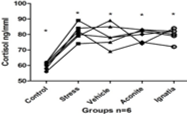Abstract
Anxiety disorders are the most common form of psychiatric disorders and start at an early age. The homeopathic system of complementary treatment is increasingly used by the general population. Ultra-diluted Aconite and Ignatia are homeopathic medicines used by clinicians for the treatment of anxiety. The objective of this study is to test the efficacy of Aconite 12CH and Ignatia 12CH on experimental anxiety models of Wistar rats subjected to chronic unpredictable stress. 30 Wistar rats were divided into 5 groups of Control, Stress, Vehicle, Aconite and Ignatia group with 6 animals in each group. All the groups were subjected to chronic unpredictable stress except the control group. The last two groups were fed Aconite and Ignatia through oral gavage daily for 5 weeks. Following this, a behavioral and biochemical assessment was done. It was observed that the Aconite and Ignatia treated animals showed better weight gain, but the behavioral and biochemical assessment did not show any significant change. Hence it was inferred that ultra-diluted Aconite and Ignatia though an anxiolytic used clinically, did not decrease anxiety in Wistar rats which were subjected to chronic unpredictable stress.
Full text article
References
Alibeu, P., Jobert, J. 1990. Aconite in homeopathic relief of post-operative pain and agitation in children. Pediatrie, 45(7-8):465–466.
Anser, H., Ikram, R., Khatoon, H., Naeem, S., Khan, S.S., Nazim, U., Ishaque, S. 2020. Comparison of the antidepressant-like activity of homeopathic remedies (Argentum nitricum, Staphysagria and Ignatia amara) and their effect on the behavior of rodents. Pakistan Journal of Pharmaceutical Sciences, 33(3):937–945.
Bondi, C.O., Rodriguez, G., Gould, G. G., Frazer, A., Morilak, D.A. 2008. Chronic Unpredictable Stress Induces a Cognitive Deficit and Anxiety Like Behavior in Rats that is Prevented by Chronic Antidepressant Drug Treatment. Neuropsychopharmacology, 33(2):320–331.
Close, S.M. 2000. The Genius of Homeopathy Lectures and Essays on Homeopathic Philosophy. Chapter XIII. Homœopathic Posology. Accessed on 10 April 2021.
Cryan, J.F., Sweeney, F.F. 2011. The age of anxiety: role of animal models of anxiolytic action in drug discovery. British Journal of Pharmacology, 164(4):1129–1161.
Edwards, J. 1981. Adverse effects of antianxiety drugs. Drugs, 22(6):495–514.
Faravelli, C. 2012. Childhood stressful events, HPA axis and anxiety disorders. World Journal of Psychiatry, 2(1):13–13.
Fisher, P. 2012. What is Homeopathy an Introduction. Frontiers in Bioscience, 4(5):1669–1682.
Haine, G., Ghandour, S.E., Ghandour, S.E., Fréz, A. 2012. Assessment of homeopathic medicine Aconitum napellus in the treatment of anxiety in an animal model. International Journal of High Dilution Research, 11(38):33–42.
Kent 2021. Ignatia amara. International Academy of Classical Homeopathy. Accessed on 10 April 2021.
Kessler, R.C., Aguilar-Gaxiola, S., Alonso, J., Chatterji, S., Lee, S., Ormel, J., Üstün, T.B., Wang, P.S. 2009. The global burden of mental disorders: An update from the WHO World Mental Health (WMH) Surveys. Epidemiologia e Psichiatria Sociale, 18(1):23–33.
Lenze, E.J. 2000. Comorbid Anxiety Disorders in Depressed Elderly Patients. American Journal of Psychiatry, 157(5):722–728.
Locke, A., Kirst, N., Shultz, C.G. 2015. Diagnosis and management of generalized anxiety disorder and panic disorder in adults. American family physician, 91(9):617–624.
Marzotto, M., Conforti, A., Magnani, P., Zanolin, M.E., Bellavite, P. 2012. Effects of Ignatia amara in mouse behavioural models. Homeopathy, 101(1):57–67.
Milgrom, L. 2006. Is homeopathy possible? Journal of the Royal Society for the Promotion of Health, 126(5):211–218.
Munk-Jørgensen, P., Allgulander, C., Dahl, A.A., Foldager, L., Holm, M., Rasmussen, I., Virta, A., Huuhtanen, M.-T., Wittchen, H.-U. 2006. Prevalence of Generalized Anxiety Disorder in General Practice in Denmark, Finland, Norway, and Sweden. Psychiatric Services, 57(12):1738–1744.
Oberbaum, M., Schreiber, R., Rosenthal, C., Itzchaki, M. 2003. Homeopathic treatment in emergency medicine: a case series. Homeopathy, 92(1):44– 47.
Onos, K.D., Rizzo, S.J.S., Howell, G.R., Sasner, M. 2016. Toward more predictive genetic mouse models of Alzheimer’s disease. Brain Research Bulletin, 122:1–11.
Relton, C., Cooper, K., Viksveen, P., Fibert, P., Thomas, K. 2017. Prevalence of homeopathy use by the general population worldwide: a systematic review. Homeopathy, 106(2):69–78.
Tiller, J.W.G. 2013. Depression and anxiety. Medical Journal of Australia, 199(6):28–31.
Wittchen, H.-U., Jacobi, F. 2005. Size and burden of mental disorders in Europe—a critical review and appraisal of 27 studies. European Neuropsychopharmacology, 15(4):357–376.
Wittchen, H.U., Zhao, S., Kessler, R.C., Eaton, W.W. 1994. DSM-III-R generalized anxiety disorder in the National Comorbidity Survey. Archives of general psychiatry, 51(5):355–364.
Authors

This work is licensed under a Creative Commons Attribution-NonCommercial-NoDerivatives 4.0 International License.

